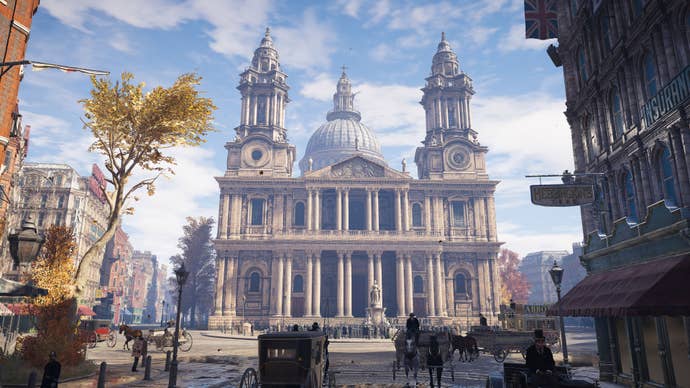Assassin's Creed Syndicate: What it Takes to Rebuild 1868 London
Mike talks to Assassin's Creed Syndicate's world director and historian about recreating London at the end of the Industrial Revolution.
This article first appeared on USgamer, a partner publication of VG247. Some content, such as this article, has been migrated to VG247 for posterity after USgamer's closure - but it has not been edited or further vetted by the VG247 team.
A large part of any Assassin's Creed game is the era it takes place in. Each era and city has its own fingerprint, it's own rhythm. For Ubisoft, the challenge is crafting a city that feels historically authentic while also providing gamers with a great playground. Not every city is built for parkour and assassinations, but Ubisoft has to make sure that their version is.
Assassin's Creed Syndicate is set in London, England in 1868. This era of the city comes at the end of the Industrial Revolution. With the rise in technologies like steam power, textile manufacturing, gas lighting, and iron working, the city of London became the seat for the world's progress. It was a place of great affluence, with the best and brightest from around the world coming to make their home there. It was also a place of great poverty, with an underclass of citizens toiling and dying in factories and slums.
Into this cauldron of progress and poverty comes neophyte assassins Evie and Jacob Frye. Together with London's alone assassin, Henry Green, the Frye Twins hope to take down Templar Crawford Starrick, who rules London with an iron fist. You'll travel across seven major areas in London: the city of London proper, the Thames, Whitechapel, The Strand, Westminster, Lambeth, and Southwark. That journey will also take the twins on top of and inside some of London's best landmarks, including Westminster Abbey and Palace, Buckingham Palace, St. Paul's Cathedral, Trafalgar Square, and the Tower of London.
I spoke with Assassin's Creed Syndicate world designer Jonathan Dumont and historian Jean-Vincent Roy about what it takes to rebuild 1860s London and make a historical playground for gamers.
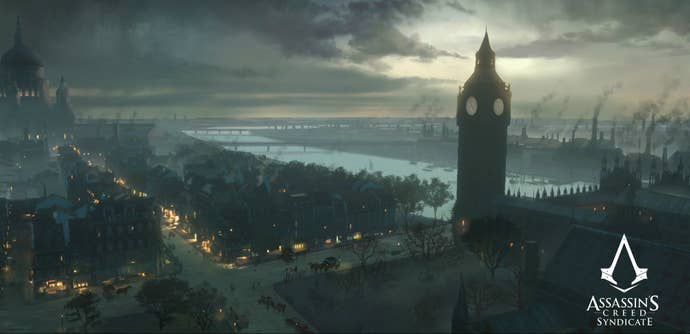
It's important to note that while Ubisoft strives for historical accuracy in each Assassin's Creed game, that's not the primary focus. The studios are still trying to make an enjoyable game. Things like movement and flow through the city are paramount.
"On the one hand, we're creating a video game, so the overriding factor is fun. Immersion, gameplay, fluidity, all these things," said historian Jean-Vincent Roy. "Then you have historical accuracy, which is important for us. The key concept came from Marc-Alexis Cote, the creative director, who said, 'We're after a highly credible impression of London. We're not doing a simulation.'"
That "highly credible impression" means that while parts of London are 100 percent accurate, there have been changes to the overall size of city.
"We were looking at maps and the sheer distance that a player would have to cross seemed to be too long in one direction and too short in the other," said Roy. "We had to compress and stretch a little to adapt the city for our purposes."
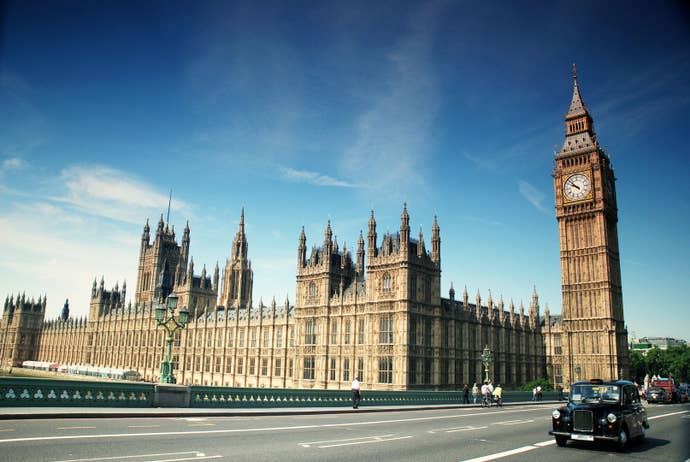

"We did a lot of research, reviewing maps and photos," added Dumont. "We were lucky enough to have photography for our time period. After that we ask how, gameplay-wise, is this city going to feel? The portion of the city that we portrayed is a little bit longer in real life, so we had to condense it a bit. We recreate landmark areas with a great deal of fidelity, but after that, you need to shrink some space so that travel distance feels okay."
"The elbow shape of the Thames, we needed that absolutely. It shapes the whole city, so that we didn't cheat at all. Putting the landmarks where they're supposed to be was important. Then in-between, depending on certain interesting areas, level design would take over more."
When it comes to landmarks like Westminster Abbey or Buckingham Place, Ubisoft leans on a 1-to-1 recreation. Dumont called the landmarks in the game "mostly authentic," noting that tiling and texture work sometimes differ from the real thing. Part of that is development logistics and part of it is the materials the artists have to work with.
"For instance, this circle on [St. Margaret's Church in Westminster Abbey]? That's actually a sundial," Roy explained. "It was installed in 1982. Some artists referencing pictures put the dial in and I had to go back and say 'You'll have to remove that, because it wasn't there. You have to replace that with a real clock!' Then I produced this blurry picture where you can't see the clock really well, but the artist has to work from it for cross-referencing to make it right. This is the kind of stuff that I was very involved with."

Outside of the landmarks, Ubisoft strives to bring across the spirit of specific boroughs around the city. Everywhere in 1860s London had the contrast of intense affluence and intense poverty, but even beyond that, each area has its own smaller fingerprint. Whitechapel is not Lambert, and neither of them look quite like Westminster.
"We came here to London to visit for about a week and we walked the city to get the vibe of it," said Dumont. "St. James on the Parkway is wide for example; these are values that we wanted to put in. Making sure that these pockets are self-contained, so that you get the spirit of the place."
"We researched the period and the area is one of contrasts; you have the slums and the fabulous richness. When you think about Victorian London, you instantly think about Whitechapel," replied Roy when I asked about areas of the city that felt particularly special to him. "Dark back alleys, the foggy, rainy London. This is something we obviously wanted to include in the game."
"Buckingham Palace and the Westminster area was also super-important. Those two stood out early in the process, but as we got further, we realized that the Southend was pretty interesting, showcasing the industrial side of London. Covent Garden and the Strand, was more of an uplifting area. One after the other, all these areas fell into place and made the city work in a way that we wanted to logically showcase the city."

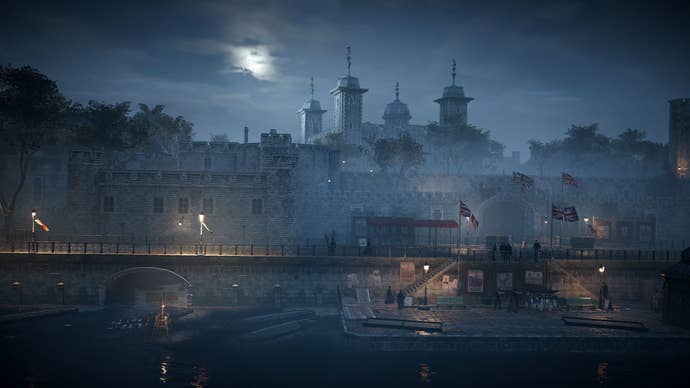
As I noted in my hands-on preview of the game, one of the biggest changes for this Assassin's Creed is the addition of moving parts in the cities. Carriages, trains, and ships act as moving platforms and buildings, providing areas for players to move and fight on. For Ubisoft, this idea was one of their earliest priorities.
"Initially, the order that we gave ourselves is we wanted more dynamic experiences," said Dumont. "Some of the first drawings we had was fighting on top of a big train. From the start, those are things that we started playing with."
"The train layout we had to fudge a bit to make sure that it loops," he continued, detailing some of the changes made to make the gameplay work. "Typically, the train station would bring trains from outside, but they wouldn't necessarily interconnect. We had to interconnect them so you'd jump on a train and not just leave the map."
According to Dumont, carriages also presented a development challenge. Usually Ubisoft crafts the buildings and then creates the city streets around them. For Syndicate, they had to build the streets first because carriages required a full, working traffic system.
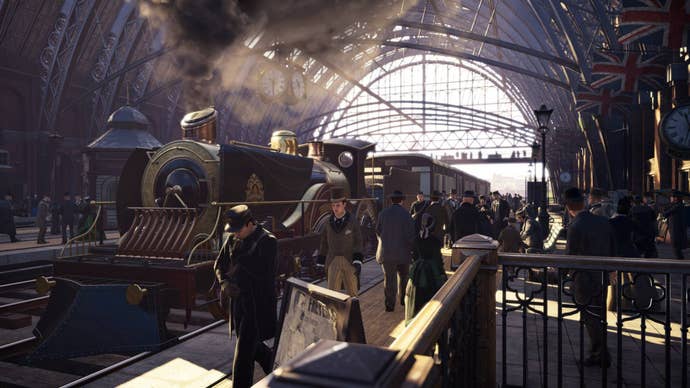
"It took quite a bit of time to find the right rhythm for [carriages]," he told me. "We weren't sure how people were going to use it. 'Is this too much of a wild card thing?' we asked. When we decided to make a more realistic city with a street system and people on the sidewalk, it came together when the traffic system got implemented. It was a rethink because we didn't start with the buildings, we started with the streets, so we needed layouts. Typically, you would place your building so that you'd have gameplay pockets, but we built the streets first and then we placed the buildings."
For Roy, the line between historical accuracy and gameplay was a rope straining in a tug of war. The larger areas of the city were more malleable, but the historians were able to stake a claim on the details of life in 1868 London.
"Sometimes I fought and won, sometimes I fought and lost," said Roy about the battle for historical accuracy. "My examples all have to deal with detail. In the beginning, when we integrated carriages, all our carriages had only one horse. Then I visited the London Fire Brigade Museum and a retired veteran told me that steam fire engines were always drawn by two horses. This is a thing I fought for, because I wanted us to have this variety, where you have larger carts."

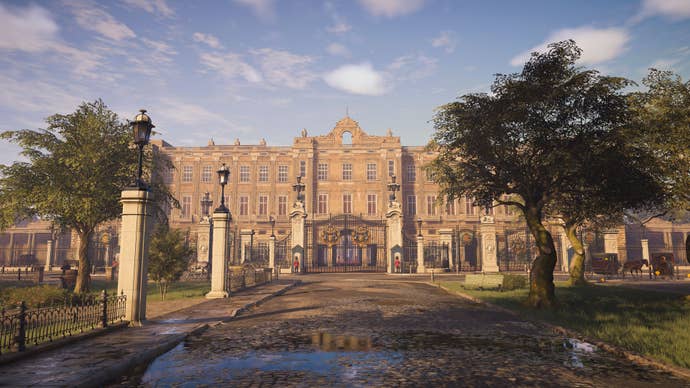
"A good example of gameplay overriding history is police," he continued. "The Metropolitan police uniform was such a dark blue that it was almost black. It was very easy to not notice the police among the crowd. We had to use a paler shade of blue to make them stand out a bit better, for the situational awareness of the player. We also have armed police with revolvers. Back then, they had truncheons. They did have access to service revolvers, but generally speaking that was at the station. In our game, since everyone is armed, we considered it fair to give them a gun too."
For Roy and the rest of the historians working on Assassin's Creed Syndicate, the game is sort of a dream come true. No, the city of London isn't a strict recreation of the real thing, but it's close enough that the historians have a chance to see the things they only read about in books come to life.
"This is absolutely amazing," said Roy when asked about what it was like to see the game come together. "It was always a concern for us to be as close to historically accurate as possible given the nature of the project. I don't play the game like anyone else. I very much walk the city. To see the city living on its own and being so lively... when the city illuminates at night, it's absolutely gorgeous. You get the feeling that you're walking into a Grimshaw painting."
It's not my favorite era or city - I'm still waiting on Sengoku Era Japan - but Syndicate's London feels different from some of the other environments we've had to assassinate in. It's bigger and wider than what we've seen before, justifying new additions like the rope launcher and carriages. You'll get a chance to see how comprehensive Ubisoft's recreation of London is when Assassin's Creed Syndicate hits PlayStation 4 and Xbox One on October 23, 2015.

